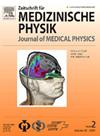A noise-robust post-processing pipeline for accelerated phase-cycled 23Na Multi-Quantum Coherences MRI
IF 4.2
4区 医学
Q2 RADIOLOGY, NUCLEAR MEDICINE & MEDICAL IMAGING
引用次数: 0
Abstract
Purpose
To develop an improved post-processing pipeline for noise-robust accelerated phase-cycled Cartesian Single (SQ) and Triple Quantum (TQ) sodium (23Na) Magnetic Resonance Imaging (MRI) of in vivo human brain at 7 T.
Theory and Methods
Our pipeline aims to tackle the challenges of 23Na Multi-Quantum Coherences (MQC) MRI including low Signal-to-Noise Ratio (SNR) and time-consuming Radiofrequency (RF) phase-cycling. Our method combines low-rank k-space denoising for SNR enhancement with Dynamic Mode Decomposition (DMD) to robustly separate SQ and TQ signal components. This separation is crucial for computing the TQ/SQ ratio, a key parameter of 23Na MQC MRI. We validated our pipeline in silico, in vitro and in vivo in healthy volunteers, comparing it with conventional denoising and Fourier transform (FT) methods. Additionally, we assessed its robustness through ablation experiments simulating a corrupted RF phase-cycle step.
Results
Our denoising algorithm doubled SNR compared to non-denoised images and enhanced SNR by up to 29% compared to Wavelet denoising. The low-rank approach produced high-quality images even at later echo times, allowing reduced signal averaging. DMD effectively separated the SQ and TQ signals, even with missing RF phase cycle steps, resulting in superior Structural Similarity (SSIM) of and lower Root Mean Squared Error (RMSE) of compared to conventional FT methods (SSIM=, RMSE=). This pipeline enabled high-quality 8x8x15mm3 in vivo 23Na MQC MRI, with a reduction in acquisition time from 48 to 10 min at 7 T.
Conclusion
The proposed pipeline improves robustness in 23Na MQC MRI by exploiting low-rank properties to denoise signals and DMD to effectively separate SQ and TQ signals. This approach ensures high-quality MR images of both SQ and TQ components, even in accelerated and incomplete RF phase-cycling cases.
加速相循环23Na多量子相干MRI的噪声鲁棒后处理管道。
目的:开发一种改进的后处理流程,用于7 t时人体大脑的抗噪加速相循环笛卡尔单量子(SQ)和三量子(TQ)钠(23Na)磁共振成像(MRI)。理论和方法:我们的流程旨在解决23Na多量子相干(MQC) MRI的低信噪比(SNR)和耗时的射频(RF)相循环的挑战。该方法结合了低秩k空间去噪和动态模态分解(DMD)来鲁棒分离SQ和TQ信号分量。这种分离对于计算TQ/SQ比至关重要,TQ/SQ比是23Na MQC MRI的一个关键参数。我们在硅、体外和健康志愿者体内验证了我们的管道,并将其与传统的去噪和傅立叶变换(FT)方法进行了比较。此外,我们通过模拟损坏的射频相位周期步骤的烧蚀实验来评估其鲁棒性。结果:与未去噪图像相比,我们的去噪算法的信噪比提高了一倍,与小波去噪相比,信噪比提高了29%。低秩方法产生高质量的图像,即使在较晚的回波时间,允许减少信号平均。DMD能够有效地分离SQ和TQ信号,即使缺少RF相位周期步长,与传统的FT方法(SSIM=0.71±0.061,RMSE=0.144±0.036)相比,其结构相似性(SSIM)为0.89±0.024,均方根误差(RMSE)为0.055±0.008。该管道实现了高质量的8x8x15mm3体内23Na MQC MRI,在7 t时采集时间从48缩短到10 min。结论:该管道通过利用低秩特性去噪信号和DMD有效分离SQ和TQ信号,提高了23Na MQC MRI的鲁棒性。这种方法可确保SQ和TQ组件的高质量MR图像,即使在加速和不完全RF相位循环的情况下也是如此。
本文章由计算机程序翻译,如有差异,请以英文原文为准。
求助全文
约1分钟内获得全文
求助全文
来源期刊
CiteScore
3.70
自引率
10.00%
发文量
69
审稿时长
65 days
期刊介绍:
Zeitschrift fur Medizinische Physik (Journal of Medical Physics) is an official organ of the German and Austrian Society of Medical Physic and the Swiss Society of Radiobiology and Medical Physics.The Journal is a platform for basic research and practical applications of physical procedures in medical diagnostics and therapy. The articles are reviewed following international standards of peer reviewing.
Focuses of the articles are:
-Biophysical methods in radiation therapy and nuclear medicine
-Dosimetry and radiation protection
-Radiological diagnostics and quality assurance
-Modern imaging techniques, such as computed tomography, magnetic resonance imaging, positron emission tomography
-Ultrasonography diagnostics, application of laser and UV rays
-Electronic processing of biosignals
-Artificial intelligence and machine learning in medical physics
In the Journal, the latest scientific insights find their expression in the form of original articles, reviews, technical communications, and information for the clinical practice.

 求助内容:
求助内容: 应助结果提醒方式:
应助结果提醒方式:


